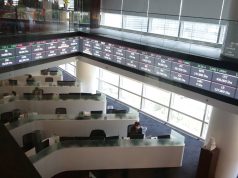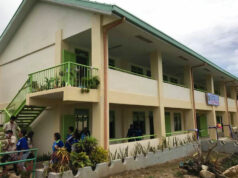Q1 GDP growth slowest in 4 years
PHILIPPINE gross domestic product (GDP) grew by 5.6% in the first quarter, its worst performance in four years, the Philippine Statistics Authority reported on Thursday.
The first-quarter outcome was lower than the 6.3% in the preceding quarter and 6.5% in the first quarter of 2018.
This was likewise lower than the 6.1% median estimate in BusinessWorld’s poll of 20 economists last week and the downward revised 6-7% target set by the government for 2019.
Socioeconomic Planning Secretary Ernesto M. Pernia said in a news briefing yesterday this was the slowest growth rate recorded in 16 quarters, or since the 5.1% logged in the first quarter of 2015.
The first-quarter turnout also snapped the economy’s growth streak of 16 quarters when it registered at least six percent growth.
In a joint statement, the Department of Finance, the National Economic and Development Authority (NEDA) and the Department of Budget and Management said that in order “[t]o reach the [floor of the] full-year growth target of 6-7%, the economy will need to expand by an average of 6.1% over the next three quarters.”
“This target is still within reach, should the private sector sustain its current performance and government be able to jumpstart and speed up the implementation of its new programs and projects.”
On the supply side, services led the way with seven percent expansion, faster than the 6.7% recorded a year ago.
Industry grew by 4.4%, slower than last year’s 7.7%.
Growth in agriculture, hunting, forestry and fishing slowed to 0.8% versus the year-ago 1.1%.
Mr. Pernia, who is NEDA’s director-general, further noted in the briefing that the agriculture slowdown is an effect of the current El Niño episode that is expected to last until August.
On the demand side, government spending grew 7.4% in the first three months of 2019, albeit slower than the 13.6% growth in the first quarter of 2018.
“As we have forewarned repeatedly, the re-enacted budget would sharply slow the pace of our economic growth,” Mr. Pernia said.
“We estimate that we should have grown by as much as 6.6% this first quarter, if we were operating under the 2019 fiscal program.”
The government operated on a re-enacted 2018 budget from the start of the year until April 15, when President Rodrigo R. Duterte signed the latest general appropriations into law, but vetoed P95.3 billion in appropriations that he said were not in accordance with his administration’s priorities, slashing this year’s national budget to about P3.662 trillion.
In a research note, HSBC Global Research economists Noelan Arbis and Joseph Incalcaterra noted that the 2019 budget’s nearly four-month delay has “likely curtailed government spending growth,” adding that higher bank lending rates and low domestic market liquidity “likely caused the slowdown in fixed investment.”
“Indeed, government consumption growth registered its slowest pace in two years and fixed investment growth declined to its lowest in five years, implying a drastic shift in economic activity from recent quarters,” they said.
BROAD-BASED WEAKNESS
In an e-mail to reporters, Standard Chartered Bank economist Chidu Narayanan cited “broad-based weakness” in the economy, noting that “… the details of the [first-quarter] GDP print… suggests that the budget impasse was not the only reason for the slowdown…”
“Household consumption was the only source of strength,” Mr. Narayanan said.
“Government expenditure, capex (capital expenditures) and net exports all slowed in the quarter.”
Growth of private investment, represented in the data as capital formation, slowed to 6.8% last quarter from 10.3% previously. Investments in fixed capital — which includes construction and durable equipment among others — grew 5.73% in the first quarter, the slowest pace since 5.67% in 2014’s second quarter.
A bright spot in the GDP report was household spending, which accounts for about 70% of GDP and which grew 6.3% last quarter, accelerating from 5.3% in the fourth quarter of 2018 and 5.6% in the first quarter of 2018.
Robert Dan J. Roces, chief economist at Security Bank Corp., blamed persistent weakness in trade also for the economic growth slowdown.
“Market analysts and forecasters have long anticipated that the delayed budget was already factored in, and thus government spending ‘still existed’ despite a reenacted budget in [the first quarter]. What was unexpected was the broader drag from the tepid trade component of the GDP, thus a lower than the anticipated growth rate,” Mr. Roces said in a note to reporters.
HSBC’s Messrs. Arbis and Incalcaterra likewise noted a “significant drag on the net export front.”
“Total export volumes expanded only 5.8% year on year, the slowest pace since 2015. Meanwhile, import volumes slowed more moderately, expanding at 8.3%. As a result, the net export deficit rose to 7.8% of GDP, the highest on record.”
Gross national income — the sum of GDP and net income from abroad — grew 4.9% last quarter compared to 5.7% the preceding quarter and 6.3% in the 2018’s first three months.
In a separate statement, Finance Secretary Carlos G. Dominguez III said that the first quarter’s 5.6% GDP growth is still a “decent expansion” despite the budget delay that caused the government to miss spending P1 billion a day in the first four months.
“The Duterte administration aims to offset the lower spending at the outset of 2019 resulting from the budget delay and the construction ban during the election season,” Mr. Dominguez said.
“Henceforth, we expect growth to pick up on higher state spending in continuance of last year’s upward momentum.”
According to the Bureau of the Treasury, state disbursements missed targets by 11%, totaling P777.99 billion in the first quarter, although spending overall was up one percent from a year earlier.
Meanwhile, first-quarter fiscal deficit shrank 41% year-on-year to P90.245 billion, missing the program by 52%. In March alone, the fiscal deficit shrank by 47% annually to P58.409 billion, falling 51% short of program.
For Emilio S. Neri, Jr., lead economist at Bank of the Philippine Islands, the details of the GDP report “actually paint an encouraging picture for the Philippine economy” despite the disappointing turnout in the first quarter.
“The recovery of household consumption and the stable growth of private construction suggest that private spending remains strong, with support coming from low inflation and election spending. Meanwhile, weak government expenditure is just temporary as the national budget was already approved, which allows the government to catch up later this year in terms of its infrastructure program,” Mr. Neri said in a note.
“Hence, the economy can still grow by at least six percent in 2019. We note that GDP growth was only 5.1% in [the first quarter of] 2015, and yet the economy still expanded by 6.1% in [full year] 2015.” — Marissa Mae M. Ramos with inputs from Reicelene Joy N. Ignacio




